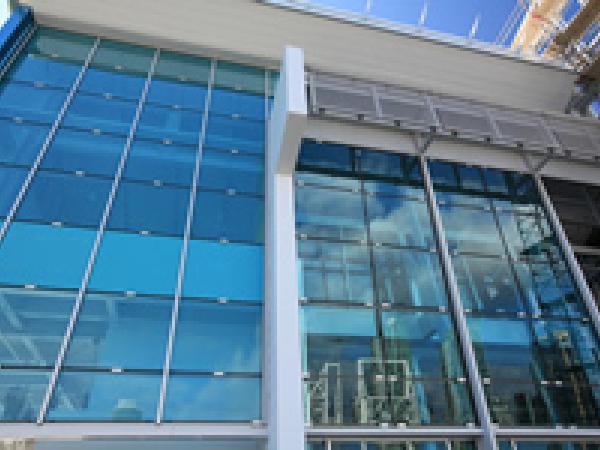And while glazing has myriad properties that would be essential to consider from a building occupant, owner or architectural perspective, the ones called out specifically in energy codes and standards are u-value (also commonly referred to as u-factor) and solar heat gain coefficient (SHGC).
Essential Glazing Factors
U-value represents the thermal transmittance, or heat transmission through a unit area of material or construction assembly and the boundary air films, induced by unit temperature difference between the environments on each side, measured in Btu/hr-sq ft-°F.
SHGC is the ratio of the solar heat gain entering the space through the fenestration area to the incident solar radiation. Solar heat gain includes directly transmitted solar heat and absorbed solar radiation, which is then reradiated, conducted, or convected into space.
The fenestration area (at least as far as ASHRAE 90.1 is concerned) refers to the total area measured using the rough opening and including the glazing, sash, and frame. So when the standard calls out an assembly maximum, it’s not just center-of-glass values we need to take into consideration.
Glazing and Cooling Loads
Oftentimes, decisions regarding building glazing can contribute upwards of 20% of the required cooling load of a building. In buildings where energy-efficiency is critical, both increasingly strict energy code requirements and green building rating systems, are forcing the specification of high performance envelope components to becoming more and more critical.
Therefore, specific window performance information (such as u-factor and shading coefficient/solar heat gain coefficient) are becoming more important aspects of project construction documents. And several high performance window design strategies are available on the market today to maximize efficiency while maintaining visual characteristics. Essentially a window’s energy efficiency is dependent on its framing, glass and operation.
Frames can conduct heat, and since they’re oftentimes metal this heat can be significant, so aluminum frames should always have a thermal break (an insulating plastic strip between the inside and outside of the frame and sash) to reduce heat loss and frame u-factor. Composite, wood, fiberglass and vinyl are also available options (but typically relegated to residential use). They all have pluses and minuses with regard to cost, maintenance and longevity as well (more information at http://www.energysavers.gov/your_home/windows_doors_skylights/index.cfm/...).
Operation is another aspect that’s often a moot point in commercial buildings since glazing is mostly fixed (meaning it doesn’t open). Some operations (awning, casement, and hopper) have lower air leakage rates than others and double hung or sliding), which should be taken into consideration for operable windows.
Finally, the big variable, glass type… there is no ‘one size fits all’ glass for every application. Final selections for the same building might even differ by orientation or location in the wall assembly. Factors like orientation, climate, and building design all play their part here. And since glazing technologies can be combined there are many types available. The main technologies can be separated into six main categories, as described below:
Six Glazing Technologies to Consider
Gas Fills: In glazing assemblies with multiple panes, adding a gas fill helps improve the thermal performance of the assembly by providing additional resistance to heat flow over standard air to decrease a window's u-value. Gasses utilized are inert (don't react readily with other elements), commonly argon and krypton. Argon is less expensive, but Krypton has better thermal performance.
Heat-absorbing tints: Such tints change the color of the glass to absorb a large fraction of the incoming solar radiation, reducing SHGC, visible transmittance and glare. Some heat can still pass through by conduction and radiation, however, which means that tint does not lower a window's u-value.
Insulated glazing: Insulating glazing refers to windows with two or more panes of glass (such as double-glazed or triple-glazed). Insulation is achieved through spacing the glass panes apart and hermetically sealing them to form a single unit with an air gap, which helps resist heat flow. This lowers both the u-value and SHGC.
Low-emissivity (Low-E) coatings: Such coatings control heat transfer through windows with insulated glazing.
A microscopically thin metallic or metallic oxide layer is deposited directly on the surface of a glass pane. These coatings reduce the infrared radiation from one pane to another, lowering the u-value of the window (but can also lower the visible transmittance). Low-e coatings are available for high, moderate or low solar gain.
The low-e coating should be applied to the outside pane of glass to keep heat out and to the inside pane of glass to keep heat inside the house. Windows produced with these coatings typically cost 10-15% more but reduce energy loss by as much as 30-50% compared to non-coated windows.
Reflective coatings: Reflective coatings are usually composed of thin, metallic layers, such as silver, gold or bronze. These coatings reduce the transmission of solar radiation, while blocking more light than heat. As a result visible transmittance and glare are significantly reduced with a lesser reduction in SHGC.
Spectrally selective coatings: These coatings are a special type of low-e coating that filters out 40-70% of heat normally transmitted through insulated glazing, while at the same time allowing the full amount of light to be transmitted.
Such coatings reflect particular wavelengths (like infrared) but remain transparent to others (like visible). This results in both a low u-value and low SHGC with high visible transmittance.
By Sarah Gudeman, LEED AP, EIT, Morrissey Engineering, Inc.
Source: www.green-buildings.com/content/781972-architectural-glass-6-glazing-technologies-consider























